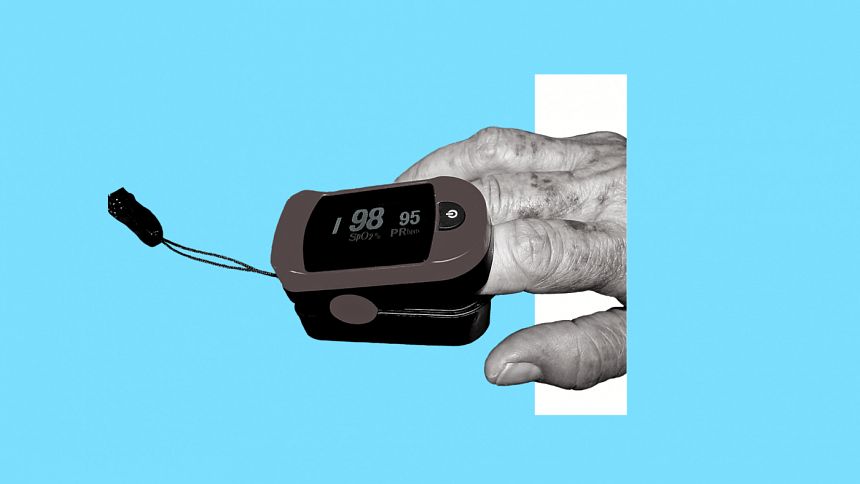Pulse Oximeter: Everything you need to know before getting one

Silent hypoxia is one of the symptoms in which Covid-19 patients have alarmingly low blood oxygen saturation levels, yet they do not show any other symptoms of Covid-19 or breathlessness to identify the hidden danger. The pulse oximeter, a non-invasive device of arterial blood oxygen saturation and pulse rate, can help people to monitor the symptoms at home, and ask for medical care sooner before this deadly symptom kills them. It has been in high demand recently, although it is not always reliable to identify that you are Covid-19 positive or not. But you can consult a doctor if you find any abnormality in the pulse oximeter reading.
How does a pulse oximeter work?
It uses light to work out oxygen saturation levels. The probe has a light source on the upper side and a light indicator on the lower side. When a finger is placed on the probe, a part of the light will be absorbed and the rest won't be. The amount of light that is absorbed depends on the physical properties. And these are used by the pulse oximeter to determine the oxygen saturation. According to the World Health Organization (WHO), oxygen saturation (SpO2) should be between 95% and 100%. If the rate is 94% or less than it, the person needs to be treated quickly. Less than 90% of oxygen saturation is a clinical emergency. The normal perfusion index (PI) ranges from 0.02% to 20% showing weak to strong pulse strength.
How accurate is it?
You can never say that your oximeter is 100% accurate. It can show a 2% over or 2% under due to your arterial blood gas or mechanical fault. Remember that while determining an emergency. For example, if your oxygen saturation is 96% according to a pulse oximeter, then it is anywhere between 94% and 98%. And some factors may affect the actual reading too.
Factors that might adulterate a pulse oximeter reading
According to the World Health Organization (WHO), nail varnish or any kind of pigment on the finger, user's movement, bright light on the probe, poor perfusion, and carbon monoxide poisoning might adulterate or stop a pulse oximeter reading.
Nail varnish: Nail polish colours contain organic or inorganic pigments that can absorb the light emitted from the oximeter that detects the pulse rate. These can work as a hindrance on the way to show the actual oxygenated haemoglobin of a person. So it's always best to remove nail colours to avoid the confusions. For emergency, put the finger turning sideways.
Henna pigmentation: Henna on the hand represents dark skin pigmentation that absorbs the light at two wavelengths and allows the infrared light to infiltrate. The outcome will faulty in this case.
User's movement- If the person who is using the oximeter has a condition that leads to rapid movement or to shiver or moves being careless while checking, the pulse waveform can fluctuate. The reading will be misleading. Both the user and oximeter should be in a steady position to get the proper result.
Bright light on the probe: The interference of light on the probe will create an erratic result if it directly reaches the sensor. It has soft rubber to shield the probe from light, but when the light shines directly on the probe or the presence of radiated lights such as infrared or ultraviolet enters, it'll impact the reading.
Poor perfusion: If the perfusion index is at or below 0.4% showing weak pulse strength, then the oximeter reading can be unreliable. Peripheral artery diseases, diabetes, obesity, blood clots, etc. are the reasons of poor perfusion.
Carbon monoxide poisoning: Carbon monoxide molecules easily replace the oxygen molecules and turn haemoglobin bright red. The pulse oximeter is unable to distinguish between carbon monoxide and oxygen and so the result is faulty. For example, the reading will be misleading for up to 4 hours after smoking. People who have recently inhale smoke from fires or heavy traffic environments will also have faulty readings.
Which finger should you choose for pulse oximeter?
The third finger of the dominant hand has been considered the best option for a pulse oximeter. The second option can be the dominant thumb. That means if you are right-handed, use your right middle finger or thumb. And left middle finger or thumb for left-handed people. The difference between fingers is not huge. So it's fine if you are using your index finger.
Should one have a pulse oximeter amid this pandemic?
"Pulse oximeter does not identify Covid-19. It only shows the changes in the oxygen saturation in the blood, regardless of cause. However, the pulse oximeter is useful for monitoring oxygen levels at home, as falling oxygen saturation is an indication for hospitalization when Covid-19 is suspected. Thus, given the circumstances, it is better to have one at home", said Dr. Shahida Akhter, senior consultant at BIRDEM and professor at Ibrahim Medical College.

 For all latest news, follow The Daily Star's Google News channel.
For all latest news, follow The Daily Star's Google News channel. 



Comments